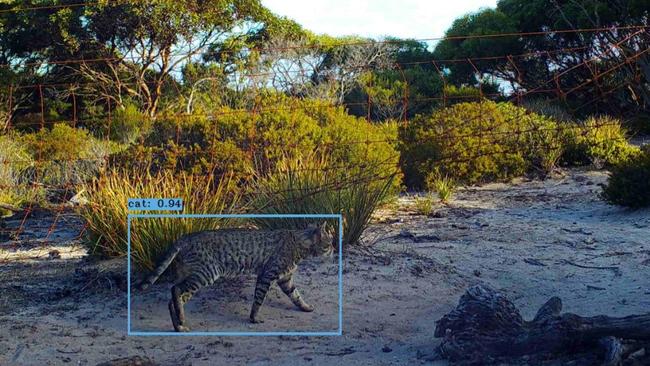New AI technology deployed on Kangaroo Island's bid to remove feral cats
Cats are known for stealth but the feral predators may struggle to escape this flashy new weapon that is always watching and waiting to unleash its arsenal.
SA News
Don't miss out on the headlines from SA News. Followed categories will be added to My News.
Flashing lights and simulated sounds such as a barking dog or bird in distress, are among features of new technology being deployed in Kangaroo Island’s battle against feral cats.
The Kangaroo Island Landscape Board is already using AI technology which involves a computer system analysing camera imagery and alerting staff if feral cats are identified, so they can deploy baits and traps.
“The cameras send an image to a big computer in Melbourne … and that computer sorts through all the images and pulls out the cat ones, and we just log into the system and it pulls up a map and shows you all the images,” feral cat eradication project leader James Smith said.
But the board will also trial a new machine learning system that turns on a deterrent device or sets traps if cats are captured on camera.

Mr Smith said deterrents such as barking sounds or flashing lights would be used to turn cats away from the Dudley Peninsula, which is being protected with a feral-proof fence.
Work building the 3km fence, isolating the peninsula from the rest of the island, is due to be completed over the coming months. It will have several gaps where roads pass through.
The board will also trial managing cats by using lures, such as a recording of a bird in distress, or a moving laser pointer.
Dr Smith said the trial would be used to study which measures had the biggest impact on controlling feral cats, so they could be deployed on other parts of the island.
“Kangaroo Island doesn’t have any deer or foxes or rabbits and goats, and soon it won’t have any pigs,” Dr Smith said.
“If we can get rid of cats, Kangaroo Island will be an amazing place for biodiversity and primary production.”
The State Government is using military-grade thermal imaging technology and a marksman to spot feral pigs from the air and shoot them.
Huge amounts of habitat were lost on the island when bushfires swept through almost half of the region during December 2019 and January 2020.
“Given that many species lost about 70 per cent of their habitat in the fire, the Dudley Peninsula is now even more important as a refuge for most of those species,” Dr Smith said.
That included animals such as the southern brown bandicoot, KI echidna, hooded plover, Bassian thrush, and Rosenberg’s goanna.
Apart from preying on native species, Dr Smith said cats also carried diseases affecting agriculture – a major source of islanders’ income.
To sponsor a camera and receive access to images of the animals it spots, head to naturefoundation.org.au.
michelle.etheridge@news.com.au



